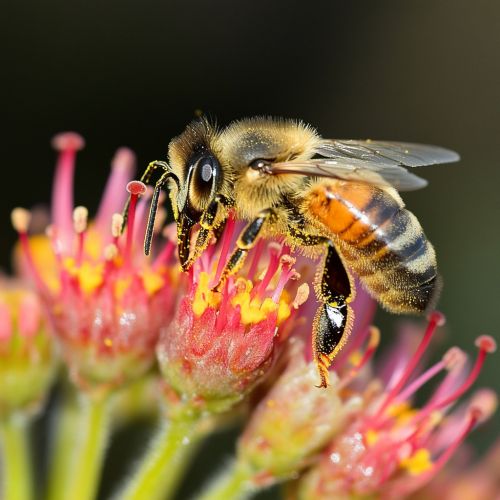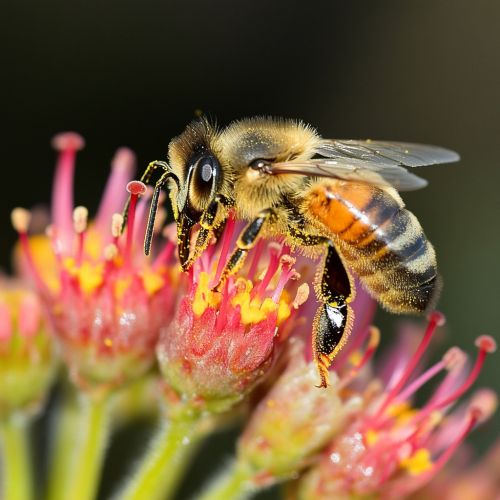Insect pollinators
Introduction
Insect pollinators play a crucial role in the reproduction of many flowering plants, including a significant portion of the world's crops. These insects transfer pollen from the male structures (anthers) of flowers to the female structures (stigmas), facilitating fertilization and the production of seeds and fruit. This article delves into the various types of insect pollinators, their ecological significance, the mechanisms of pollination, and the challenges they face.
Types of Insect Pollinators
Bees
Bees are perhaps the most well-known and effective insect pollinators. This group includes honeybees, bumblebees, solitary bees, and stingless bees. Honeybees (Apis mellifera) are particularly important for agricultural pollination due to their social structure and ability to be managed by beekeepers. Bumblebees (Bombus spp.) are also significant, especially in cooler climates where they can forage in lower temperatures.


Butterflies and Moths
Butterflies and moths are also important pollinators, particularly for plants that have flowers with long corolla tubes. Butterflies are diurnal and are attracted to brightly colored flowers, while moths are typically nocturnal and are attracted to pale or white flowers that are visible in low light.
Beetles
Beetles are among the oldest pollinators, dating back to the time of the earliest flowering plants. They are particularly important for pollinating magnolias, water lilies, and other ancient plant species. Beetles are often attracted to flowers that have strong odors and are typically less specialized than bees.
Flies
Flies, including hoverflies and bee flies, are significant pollinators, especially in habitats where bees are less common. Hoverflies (Syrphidae) are particularly important in temperate regions and are often mistaken for bees due to their similar appearance.
Wasps
While wasps are generally less efficient pollinators than bees, they do contribute to the pollination of certain plants. Fig wasps, for example, are essential for the pollination of fig trees (Ficus spp.).
Ecological Significance
Insect pollinators are vital for the maintenance of biodiversity and the functioning of ecosystems. They facilitate the reproduction of a wide variety of plants, which in turn support other organisms by providing food and habitat. The loss of insect pollinators can lead to a decline in plant diversity, which can have cascading effects throughout the ecosystem.
Mechanisms of Pollination
Pollination mechanisms vary widely among different insect pollinators and plant species. The primary methods include:
Pollen Transfer
Pollen transfer can occur through direct contact with the anthers and stigmas of flowers. Bees, for example, collect pollen in specialized structures called pollen baskets (corbiculae) on their legs and bodies.
Nectar Foraging
Many insects visit flowers primarily to collect nectar, a sugary liquid produced by the plant. While foraging for nectar, these insects inadvertently transfer pollen from one flower to another. This is particularly common in butterflies and moths.
Floral Scent and Color
Flowers have evolved a variety of scents and colors to attract specific pollinators. For example, bees are attracted to blue and violet flowers, while flies are often drawn to flowers with strong, sometimes unpleasant odors.
Challenges Facing Insect Pollinators
Insect pollinators face numerous challenges that threaten their populations and, consequently, the ecosystems and agricultural systems that depend on them.
Habitat Loss
Urbanization, agriculture, and deforestation have led to significant habitat loss for many insect pollinators. This reduces the availability of nesting sites and foraging resources.
Pesticides
The use of pesticides, particularly neonicotinoids, has been linked to declines in pollinator populations. These chemicals can be toxic to insects and can disrupt their foraging behavior and reproductive success.
Climate Change
Climate change affects the distribution and phenology of both plants and pollinators. Changes in temperature and precipitation patterns can lead to mismatches between the flowering times of plants and the activity periods of their pollinators.
Disease and Parasites
Insect pollinators are also threatened by diseases and parasites. For example, the Varroa mite (Varroa destructor) is a significant pest of honeybees, causing colony collapse disorder.
Conservation Efforts
Efforts to conserve insect pollinators include habitat restoration, the creation of pollinator-friendly gardens, and the reduction of pesticide use. International initiatives, such as the Pollinator Partnership, aim to raise awareness and promote policies that support pollinator health.
